Trillium
Trillium (trillium, wakerobin, tri flower, birthroot, birthwort) is a genus of about fifty flowering plant species in the family Melanthiaceae. Trillium species are native to temperate regions of North America and Asia,[3][4] with the greatest diversity of species found in the southern Appalachian Mountains in the southeastern United States.[5][6]
| Trillium | |
|---|---|
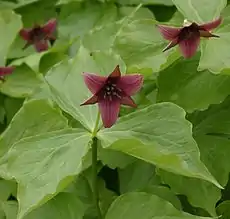 | |
| Trillium erectum (red trillium) | |
| Scientific classification | |
| Kingdom: | Plantae |
| Clade: | Tracheophytes |
| Clade: | Angiosperms |
| Clade: | Monocots |
| Order: | Liliales |
| Family: | Melanthiaceae |
| Tribe: | Parideae |
| Genus: | Trillium L. |
| Type species | |
| Trillium cernuum | |
| Synonyms[2] | |
| |
Description
Plants of this genus are perennial herbs growing from rhizomes. There are three large leaf-like bracts arranged in a whorl about a scape that rises directly from the rhizome. There are no true aboveground leaves but sometimes there are scale-like leaves on the underground rhizome. The bracts are photosynthetic and are sometimes called leaves. The inflorescence is a single flower with three green or reddish sepals and three petals in shades of red, purple, pink, white, yellow, or green. At the center of the flower there are six stamens and three stigmas borne on a very short style, if any. The fruit is fleshy and capsule-like or berrylike. The seeds have large, oily elaiosomes.[3][4]
Occasionally individuals have four-fold symmetry, with four bracts (leaves), four sepals, and four petals in the blossom.[7]
Taxonomy
In 1753, Swedish botanist Carl Linnaeus established the genus Trillium by recognizing three species, T. cernuum, T. erectum, and T. sessile.[8] The type specimen T. cernuum described by Linnaeus was actually T. catesbaei,[9] an oversight that subsequently led to much confusion regarding the type species of this genus.
Initially the Trillium genus was placed in the family Liliaceae, which by 1981 had grown to about 280 genera and 4,000 species.[10] As part of an effort to deconstruct the polyphyletic family Liliaceae, many botanists considered Trillium and related genera to constitute a separate family Trilliaceae while others defined family Melanthiaceae for a similar purpose. In 1998, the Angiosperm Phylogeny Group assigned the genus Trillium, along with genera Paris and Pseudotrillium, to the family Melanthiaceae.[11]
The Trillium genus has traditionally been divided into two subgenera, T. subg. Trillium and T. subg. Sessilium, based on whether the flowers are pedicellate or sessile (resp.). The former is considered the more primitive group of species.[12][13][3] Until recently the sessile-flowered subgenus was known by the name Phyllantherum, but the name Sessilium has precedence and should be used.[14] T. subg. Sessilium has been shown to be a monophyletic group by molecular systematics but its segregation renders the remaining T. subg. Trillium paraphyletic.[15]
All names used in this section are taken from the International Plant Names Index.[16] Unless otherwise noted, the name has been accepted by World Checklist of Selected Plant Families.[17] The geographical locations are taken from the Flora of North America[3] except where noted.
North American taxa
The following species belong to T. subg. Trillium, that is, they bear pedicellate flowers (on a short stalk) but lack mottled leaves.[18]
- Trillium catesbaei Elliott – Alabama, Georgia, North Carolina, South Carolina, Tennessee
- Trillium cernuum L. – Manitoba, New Brunswick, Newfoundland, Nova Scotia, Ontario, Prince Edward Island, Quebec, Saskatchewan; Connecticut, Delaware, District of Columbia, Illinois, Indiana, Iowa, Maine, Maryland, Massachusetts, Michigan, Minnesota, New Hampshire, New Jersey, New York, North Dakota, Ohio, Pennsylvania, Rhode Island, South Dakota, Vermont, Virginia, West Virginia, Wisconsin
- Trillium erectum L. – New Brunswick, Nova Scotia, Ontario, Quebec; Connecticut, Delaware, Georgia, Illinois, Indiana, Kentucky, Maine, Maryland, Massachusetts, Michigan, New Hampshire, New Jersey, New York, North Carolina, Ohio, Pennsylvania, Rhode Island, South Carolina, Tennessee, Vermont, Virginia, West Virginia
- Trillium flexipes Raf. – Ontario; Alabama, Delaware, Illinois, Indiana, Iowa, Kentucky, Maryland,[6] Michigan, Minnesota, Missouri, New York, Ohio, Pennsylvania, South Dakota, Tennessee, Virginia, West Virginia, Wisconsin
- Trillium grandiflorum (Michx.) Salisb. – Nova Scotia, Ontario, Quebec; Alabama, Connecticut, Delaware, Georgia, Illinois, Indiana, Iowa, Kentucky, Maine, Maryland, Massachusetts, Michigan, Minnesota, New Hampshire, New Jersey, New York, North Carolina, Ohio, Pennsylvania, South Carolina, Tennessee, Vermont, Virginia, West Virginia, Wisconsin
- Trillium nivale Riddell – Illinois, Indiana, Iowa, Kentucky, Maryland, Michigan, Minnesota, Missouri, Nebraska, Ohio, Pennsylvania, South Dakota, West Virginia, Wisconsin
- Trillium ovatum Pursh – Alberta, British Columbia; California, Colorado, Idaho, Montana, Oregon, Washington, Wyoming
- Trillium persistens W.H.Duncan – Georgia, South Carolina
- Trillium pusillum Michx. – Alabama, Arkansas, Georgia,[6] Kentucky, Louisiana, Maryland, Mississippi, Missouri, North Carolina, Oklahoma, South Carolina, Tennessee, Texas, Virginia, West Virginia
- Trillium rugelii Rendle – Alabama, Georgia, North Carolina, South Carolina, Tennessee
- Trillium simile Gleason – Georgia, North Carolina, Tennessee
- Trillium sulcatum T.S.Patrick – Alabama, Georgia, Kentucky, North Carolina, Tennessee, Virginia, West Virginia
- Trillium texanum Buckley[19] – Louisiana, Texas
- Trillium undulatum Willd. – New Brunswick, Nova Scotia, Ontario, Prince Edward Island, Quebec; Connecticut, Georgia, Kentucky, Maine, Maryland, Massachusetts, Michigan, New Hampshire, New Jersey, New York, North Carolina, Ohio, Pennsylvania, Rhode Island, South Carolina, Tennessee, Vermont, Virginia, West Virginia
- Trillium vaseyi Harb. – Alabama, Georgia, North Carolina, South Carolina, Tennessee
The following species belong to T. subg. Sessilium, that is, they bear sessile flowers (with no stalk) and have mottled leaves.[20]
- Trillium albidum J.D.Freeman – California, Oregon, Washington
- Trillium angustipetalum (Torr.) J.D.Freeman – California
- Trillium chloropetalum (Torr.) Howell – California
- Trillium cuneatum Raf. – Alabama, Georgia, Kentucky, Mississippi, North Carolina, South Carolina, Tennessee
- Trillium decipiens J.D.Freeman – Alabama, Florida, Georgia
- Trillium decumbens Harb. – Alabama, Georgia, Tennessee
- Trillium discolor Hook. – Georgia, North Carolina, South Carolina
- Trillium foetidissimum J.D.Freeman – Louisiana, Mississippi
- Trillium gracile J.D.Freeman – Louisiana, Texas
- Trillium kurabayashii J.D.Freeman – California, Oregon
- Trillium lancifolium Raf. – Alabama, Florida, Georgia, South Carolina, Tennessee
- Trillium ludovicianum Harb. – Louisiana, Mississippi, Texas
- Trillium luteum (Muhl.) Harb. – Georgia, Kentucky, North Carolina, Tennessee
- Trillium maculatum Raf. – Alabama, Florida, Georgia, South Carolina
- Trillium oostingii Gaddy – South Carolina[6]
- Trillium petiolatum Pursh – Idaho, Oregon, Washington
- Trillium recurvatum L.C.Beck – Alabama, Arkansas, Illinois, Indiana, Iowa, Kentucky, Louisiana, Michigan, Mississippi, Missouri, Ohio, Tennessee, Texas, Wisconsin
- Trillium reliquum J.D.Freeman – Georgia, South Carolina
- Trillium sessile L. – Alabama, Arkansas, Illinois, Indiana, Kansas, Kentucky, Maryland, Michigan, Missouri, New York, North Carolina, Ohio, Oklahoma, Pennsylvania, Tennessee, Virginia, West Virginia
- Trillium stamineum Harb. – Alabama, Mississippi, Tennessee
- Trillium tennesseense E. E. Schill & Floden[21] – Tennessee
- Trillium underwoodii Small – Alabama, Florida, Georgia
- Trillium viride L.C.Beck – Illinois, Missouri
- Trillium viridescens Nutt. – Arkansas, Kansas, Missouri, Oklahoma, Texas
Asian taxa
All of the following species belong to T. subg. Trillium, that is, they bear pedicellate flowers.[15]
- Trillium apetalon Makino[22][23][24] – Japan, Kuril Islands, E Russia (Sakhalin)
- Trillium camschatcense Ker Gawl.[25][26] – NE China (Jilin), Japan, Korea, Kuril Islands, E Russia (Primorsky Krai, Khabarovsk Krai, Kamchatka Peninsula, Sakhalin)
- Trillium channellii Fukuda, J.D.Freeman & Itou[27][28] – Japan (E Hokkaido)
- Trillium govanianum Wall. ex D.Don[29][30][31] – NE Afghanistan, Bhutan, China (Tibet Autonomous Region, Yunnan), N + NE India (Himachal Pradesh, Jammu and Kashmir, Sikkim, Uttarakhand), Nepal, N Pakistan
- Trillium × hagae Miyabe & Tatew.[32] – Japan, E Russia (S Sakhalin)
- Trillium × komarovii H.Nakai & Koji Ito[33] – Japan, E Russia (Primorsky Krai)
- Trillium × miyabeanum Tatew. ex J.Samej.[34] – Japan
- Trillium smallii Maxim.[35] – Japan, E Russia (S Sakhalin)
- Trillium taiwanense S.S.Ying[36][37] – E Taiwan
- Trillium tschonoskii Maxim.[38][39] – Bhutan, China (Anhui, Fujian, Gansu, Hubei, Shaanxi, Sichuan, Tibet Autonomous Region, Yunnan, Zhejiang), NE India (Sikkim), Japan, Korea, Kuril Islands, Myanmar, Russia (Sakhalin), Taiwan
- Trillium × yezoense Tatew. ex J.Samej.[40] – Japan
Other taxa
- Trillium delicatum, otherwise considered to be a subpopulation of T. decumbens, is a recently described species confined to central Georgia.[41]
- Trillium hibbersonii, otherwise known as a dwarf form of T. ovatum, is a recently described species endemic to a small region of Vancouver Island.[42]
- Trillium parviflorum V.G.Soukup is an accepted name by some authorities[43][44] while others regard this name as a synonym of T. albidum subsp. parviflorum (V.G.Soukup) K.L.Chambers & S.C.Meyers.[45][46]
- Trillium rivale S.Watson[47] has been segregated to a monotypic genus as Pseudotrillium rivale (S.Watson) S.B.Farmer.[48]
- Trillium × crockerianum Halda is an accepted name for a hybrid whose parents are T. ovatum and T. rivale.[49] Since the latter is now a member of a different genus (Pseudotrillium), T. × crockerianum is an intergeneric hybrid whose viability is in doubt.
Distribution
Trillium species are native to North America and Asia.[3][4][50]
North America
More than three dozen Trillium species are found in North America,[3] most of which are native to eastern North America. Just six (6) species are native to western North America: T. albidum, T. angustipetalum, T. chloropetalum, T. kurabayashii, T. ovatum, and T. petiolatum. Of these, only T. ovatum is pedicellate-flowered.
Canada
Trillium species are found across Canada, from Newfoundland to southern British Columbia. The greatest diversity of species are found in Ontario, Quebec, and Nova Scotia.[3]
- Alberta: T. ovatum
- British Columbia: T. ovatum
- Manitoba: T. cernuum
- New Brunswick: T. cernuum, T. erectum, T. undulatum
- Newfoundland: T. cernuum
- Northwest Territories: none
- Nova Scotia: T. cernuum, T. erectum, T. grandiflorum, T. undulatum
- Nunavut: none
- Ontario: T. cernuum, T. erectum, T. flexipes, T. grandiflorum, T. undulatum
- Prince Edward Island: T. cernuum, T. undulatum
- Quebec: T. cernuum, T. erectum, T. grandiflorum, T. undulatum
- Saskatchewan: T. cernuum
- Yukon: none
United States
Except for the desert regions of the southwestern United States, Trillium species are found throughout the contiguous U.S. states. In the western United States, species are found from Washington to central California, east to the Rocky Mountains. In the eastern United States, species range from Maine to northern Florida, west to the Mississippi River valley. Trillium species are especially diverse in the southeastern United States, in Georgia, Tennessee, Alabama, North Carolina, and South Carolina.[3] The state of Georgia is home to nineteen (19) species of trillium.
- Alabama: T. catesbaei, T. cuneatum, T. decipiens, T. decumbens, T. flexipes, T. grandiflorum, T. lancifolium, T. maculatum, T. pusillum, T. recurvatum, T. rugelii, T. sessile, T. stamineum, T. sulcatum, T. underwoodii, T. vaseyi
- Alaska: none
- Arizona: none
- Arkansas: T. pusillum, T. recurvatum, T. sessile, T. viridescens
- California: T. albidum, T. angustipetalum, T. chloropetalum, T. × crockerianum, T. kurabayashii, T. ovatum
- Colorado: T. ovatum
- Connecticut: T. cernuum, T. erectum, T. grandiflorum, T. undulatum
- Delaware: T. cernuum, T. erectum, T. flexipes, T. grandiflorum
- District of Columbia: T. cernuum
- Florida: T. decipiens, T. lancifolium, T. maculatum, T. underwoodii
- Georgia: T. catesbaei, T. cuneatum, T. decipiens, T. decumbens, T. discolor, T. erectum, T. grandiflorum, T. lancifolium, T. luteum, T. maculatum, T. persistens, T. pusillum, T. reliquum, T. rugelii, T. simile, T. sulcatum, T. underwoodii, T. undulatum, T. vaseyi
- Hawaii: none
- Idaho: T. ovatum, T. petiolatum
- Illinois: T. cernuum, T. erectum, T. flexipes, T. grandiflorum, T. nivale, T. recurvatum, T. sessile, T. viride
- Indiana: T. cernuum, T. erectum, T. flexipes, T. grandiflorum, T. nivale, T. recurvatum, T. sessile
- Iowa: T. cernuum, T. flexipes, T. grandiflorum, T. nivale, T. recurvatum
- Kansas: T. sessile, T. viridescens
- Kentucky: T. cuneatum, T. erectum, T. flexipes, T. grandiflorum, T. luteum, T. nivale, T. pusillum, T. recurvatum, T. sessile, T. sulcatum, T. undulatum
- Louisiana: T. foetidissimum, T. gracile, T. ludovicianum, T. pusillum (syn: T. texanum), T. recurvatum
- Maine: T. cernuum, T. erectum, T. grandiflorum, T. undulatum
- Maryland: T. cernuum, T. erectum, T. flexipes, T. grandiflorum, T. nivale, T. pusillum, T. sessile, T. undulatum
- Massachusetts: T. cernuum, T. erectum, T. grandiflorum, T. undulatum
- Michigan: T. cernuum, T. erectum, T. flexipes, T. grandiflorum, T. nivale, T. recurvatum, T. sessile, T. undulatum
- Minnesota: T. cernuum, T. flexipes, T. grandiflorum, T. nivale
- Mississippi: T. cuneatum, T. foetidissimum, T. ludovicianum, T. pusillum, T. recurvatum, T. stamineum
- Missouri: T. flexipes, T. nivale, T. pusillum, T. recurvatum, T. sessile, T. viride, T. viridescens
- Montana: T. ovatum
- Nebraska: T. nivale
- Nevada: none
- New Hampshire: T. cernuum, T. erectum, T. grandiflorum, T. undulatum
- New Jersey: T. cernuum, T. erectum, T. grandiflorum, T. undulatum
- New Mexico: none
- New York: T. cernuum, T. erectum, T. flexipes, T. grandiflorum, T. sessile, T. undulatum
- North Carolina: T. catesbaei, T. cuneatum, T. discolor, T. erectum, T. grandiflorum, T. luteum, T. pusillum, T. rugelii, T. sessile, T. simile, T. sulcatum, T. undulatum, T. vaseyi
- North Dakota: T. cernuum
- Ohio: T. cernuum, T. erectum, T. flexipes, T. grandiflorum, T. nivale, T. recurvatum, T. sessile, T. undulatum
- Oklahoma: T. pusillum, T. sessile, T. viridescens
- Oregon: T. albidum, T. kurabayashii, T. ovatum, T. petiolatum
- Pennsylvania: T. cernuum, T. erectum, T. flexipes, T. grandiflorum, T. nivale, T. sessile, T. undulatum
- Rhode Island: T. cernuum, T. erectum, T. undulatum
- South Carolina: T. catesbaei, T. cuneatum, T. discolor, T. erectum, T. grandiflorum, T. lancifolium, T. maculatum, T. persistens, T. pusillum, T. reliquum, T. rugelii, T. undulatum, T. vaseyi
- South Dakota: T. cernuum, T. flexipes, T. nivale
- Tennessee: T. catesbaei, T. cuneatum, T. decumbens, T. erectum, T. flexipes, T. grandiflorum, T. lancifolium, T. luteum, T. pusillum, T. recurvatum, T. rugelii, T. sessile, T. simile, T. stamineum, T. sulcatum, T. tennesseense, T. undulatum, T. vaseyi
- Texas: T. gracile, T. ludovicianum, T. pusillum (syn: T. texanum), T. recurvatum, T. viridescens
- Utah: none
- Vermont: T. cernuum, T. erectum, T. grandiflorum, T. undulatum
- Virginia: T. cernuum, T. erectum, T. flexipes, T. grandiflorum, T. pusillum, T. sessile, T. sulcatum, T. undulatum
- Washington: T. albidum, T. ovatum, T. petiolatum
- West Virginia: T. cernuum, T. erectum, T. flexipes, T. grandiflorum, T. nivale, T. pusillum, T. sessile, T. sulcatum, T. undulatum
- Wisconsin: T. cernuum, T. flexipes, T. grandiflorum, T. nivale, T. recurvatum
- Wyoming: T. ovatum
Asia
In Asia, the range of Trillium species extends from the Himalayas across China, Korea, Japan, and eastern Russia to the Kuril Islands. The greatest diversity of Trillium species is found on the islands of Japan and Sakhalin.
- Afghanistan: T. govanianum
- Bhutan: T. govanianum, T. tschonoskii
- China:[4] T. camschatcense (Jilin), T. govanianum (Tibet Autonomous Region, Yunnan), T. taiwanense (E Taiwan), T. tschonoskii (Anhui, Fujian, Gansu, Hubei, Shaanxi, Sichuan, Tibet Autonomous Region, Yunnan, Zhejiang)
- India: T. govanianum (Himachal Pradesh, Jammu and Kashmir, Sikkim, Uttarakhand), T. tschonoskii (Sikkim)
- Japan: T. apetalon, T. camschatcense, T. channellii (Hokkaido), T. × hagae, T. × komarovii, T. × miyabeanum, T. smallii, T. tschonoskii, T. × yezoense
- Korea: T. camschatcense, T. tschonoskii
- Kuril Islands: T. apetalon, T. camschatcense, T. tschonoskii
- Myanmar: T. tschonoskii
- Nepal: T. govanianum
- Pakistan:[31] T. govanianum
- Russia: T. apetalon (Sakhalin), T. camschatcense (Primorsky Krai, Khabarovsk Krai, Kamchatka Peninsula, Sakhalin), T. × hagae (Sakhalin), T. × komarovii (Primorsky Krai), T. smallii (Sakhalin), T. tschonoskii (Sakhalin)
- Taiwan: T. taiwanense, T. tschonoskii
Identification
A fully general dichotomous key requires a mature, flowering plant.[3][51][52][53] The first step is to determine whether or not the flower sits on a pedicel, which determines the subgenus. (Any mature plant may be identified to this extent, even if it is not in bloom.) Identification proceeds based on flower parts, leaves, and other characteristics. A combination of characteristics is usually required to identify the plant.
Identification of a non-flowering, non-fruiting plant with bare leaves may be difficult. Although some species of Trillium have petioles (leaf stalks) and/or distinctive leaf shapes, these features are seldom sufficient to identify the plant down to the species level.
In eastern North America, jack-in-the-pulpit (Arisaema triphyllum) is often mistaken for bare-leaved Trillium. Both species are about the same height with trifoliate leaves but the former lacks 3-way rotational symmetry and has leaf veins unlike those of Trillium.
Ecology
Trilliums are myrmecochorous, with ants as agents of seed dispersal. Ants are attracted to the elaiosomes on the seeds and collect them and transport them away from the parent plant. The seeds of Trillium camschatcense and T. tschonoskii, for example, are collected by the ants Aphaenogaster smythiesi and Myrmica ruginodis. Sometimes beetles interfere with the dispersal process by eating the elaiosomes off the seeds, making them less attractive to ants.[54] Vespicochory, seed dispersal by Vespula species (yellow jacket hornets), has also been observed for trilliums. The insects carry off the seeds and feed on the elaiosomes.[55]
Conservation
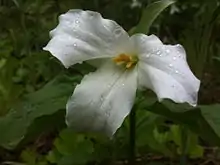
Picking parts off a trillium plant can kill it even if the rhizome is left undisturbed.[56] Some species of trillium are listed as threatened or endangered and collecting these species may be illegal. Laws in some jurisdictions may restrict the commercial exploitation of trilliums and prohibit collection without the landowner's permission. In the US states of Michigan[56] and Minnesota[57] it is illegal to pick trilliums. In New York it is illegal to pick the red trillium.[58]
In 2009, a Private Members Bill was proposed in the Ontario legislature that would have made it illegal to in any way injure the common Trillium grandiflorum (white trillium) in the province (with some exceptions), however the bill was never passed.[59] The rare Trillium flexipes (drooping trillium) is also protected by law in Ontario, because of its decreasing Canadian population.[60]
High white-tailed deer population density has been shown to decrease or eliminate trillium in an area, particularly white trillium.[61]
Some species are harvested from the wild to an unsustainable degree. This is particularly dire in the case of T. govanianum, whose high selling-price as a folk medicine has motivated harvesters to destroy swathes of ecologically sensitive Himalayan forests, causing mudslides.[62]
Medicinal uses
Several species contain sapogenins. They have been used traditionally as uterine stimulants, the inspiration for the common name birthwort. In a 1918 publication, Joseph E. Meyer called it "beth root", probably a corruption of "birthroot". He claimed that an astringent tonic derived from the root was useful in controlling bleeding and diarrhea.[63]
Culture
The white trillium (Trillium grandiflorum) serves as the official flower and emblem of the Canadian province of Ontario. It is an official symbol of the Government of Ontario. The large white trillium is the official wildflower of Ohio.[64] In light of their shared connection to the flower, the Major League Soccer teams in Toronto and Columbus compete with each other for the Trillium Cup.
Citizen scientists regularly report observations of Trillium species from around the world. T. grandiflorum, T. erectum, and T. ovatum (in that order) are the most often observed Trillium species.[65]
Trillium is the literary magazine of Ramapo College of New Jersey, which features poetry, fiction, photography, and other visual arts created by Ramapo students.[66]
In Mexican LGBT culture, the trillium is included as a symbol on their version of the bisexual pride flag.[67]
Gallery
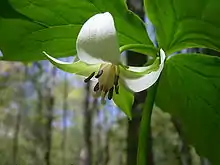 Nodding trillium (Trillium cernuum)
Nodding trillium (Trillium cernuum)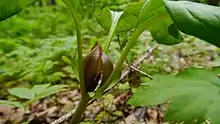 Idaho trillium (Trillium petiolatum)
Idaho trillium (Trillium petiolatum) White trillium (Trillium grandiflorum)
White trillium (Trillium grandiflorum).jpg.webp) Red trillium (Trillium erectum)
Red trillium (Trillium erectum) Pacific trillium (Trillium ovatum)
Pacific trillium (Trillium ovatum) Prairie trillium (Trillium recurvatum)
Prairie trillium (Trillium recurvatum)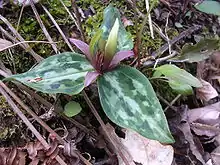 Relict trillium (Trillium reliquum) an endangered species
Relict trillium (Trillium reliquum) an endangered species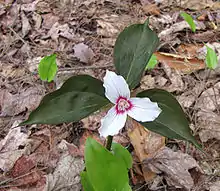 Painted trillium (Trillium undulatum)
Painted trillium (Trillium undulatum)
Bibliography
- Barksdale, Lane (1938). "The pedicellate species of Trillium found in the southern Appalachians". Journal of the Elisha Mitchell Scientific Society. 54 (2): 271–296. JSTOR 24332541.
- Case, Frederick W.; Case, Roberta B. (1997). Trilliums. Portland, Oregon: Timber Press. ISBN 978-0-88192-374-2.
- Freeman, J. D. (1975). "Revision of Trillium subgenus Phyllantherum (Liliaceae)". Brittonia. 27 (1): 1–62. doi:10.2307/2805646. JSTOR 2805646. S2CID 20824379.
References
- "Trillium". Tropicos. Missouri Botanical Garden.
- "Trillium". World Checklist of Selected Plant Families (WCSP). Royal Botanic Gardens, Kew.
- Case Jr., Frederick W. (2002). "Trillium". In Flora of North America Editorial Committee (ed.). Flora of North America North of Mexico (FNA). 26. New York and Oxford – via eFloras.org, Missouri Botanical Garden, St. Louis, MO & Harvard University Herbaria, Cambridge, MA.
- Liang, Songyun; Soukup, Victor G. "Trillium". Flora of China. 24 – via eFloras.org, Missouri Botanical Garden, St. Louis, MO & Harvard University Herbaria, Cambridge, MA.
- "Trilliums Species". United States Forest Service. Retrieved 25 June 2019.
- "Trillium". County-level distribution maps from the North American Plant Atlas (NAPA). Biota of North America Program (BONAP). 2014. Retrieved 10 August 2019.
- Kevin Kirkland, Two 4-petaled trilliums found, Pittsburgh Post-Gazette, May 11, 2013; Trillium erectum and Trillium grandiflorum examples are given.
- Case & Case (1997), p. 16.
- Barksdale (1938), pp. 271-273.
- Utech, Frederick H. (2002). "Liliaceae". In Flora of North America Editorial Committee (ed.). Flora of North America North of Mexico (FNA). 26. New York and Oxford – via eFloras.org, Missouri Botanical Garden, St. Louis, MO & Harvard University Herbaria, Cambridge, MA.
- Zomlefer, Wendy B.; Williams, Norris H.; Whitten, W. Mark; Judd, Walter S. (2001). "Generic Circumscription and Relationships in the Tribe Melanthieae (Liliales, Melanthiaceae), with Emphasis on Zigadenus: Evidence from ITS and trnL-F Sequence Data". American Journal of Botany. 88 (9): 1657–1669. doi:10.2307/3558411. JSTOR 3558411. PMID 21669700.
- Freeman (1975), p. 2.
- Case & Case (1997), p. 19.
- Reveal, J.L.; Gandhi, K.N. (16 June 2014). "Trillium subg. Sessilium Raf. (1830), an earlier name for Trillium subg. Phyllantherum (Schult. & Schult.f) J.D. Freeman (Melanthiaceae: Parideae)" (PDF). Phytoneuron. 2014–62: 1–3. ISSN 2153-733X.
- Farmer, Susan B. (2006). "Phylogenetic Analyses and Biogeography of Trilliaceae". Aliso: A Journal of Systematic and Evolutionary Botany. 22 (1): 579–592. doi:10.5642/aliso.20062201.45.
- "Search for 'Trillium'". International Plant Names Index (IPNI). Royal Botanic Gardens, Kew. Retrieved 2019-10-08.
- "Trillium". World Checklist of Selected Plant Families (WCSP). Royal Botanic Gardens, Kew.
- Case Jr., Frederick W. (2002). "Trillium subg. Trillium". In Flora of North America Editorial Committee (ed.). Flora of North America North of Mexico (FNA). 26. New York and Oxford – via eFloras.org, Missouri Botanical Garden, St. Louis, MO & Harvard University Herbaria, Cambridge, MA.
- "Trillium texanum". World Checklist of Selected Plant Families (WCSP). Royal Botanic Gardens, Kew. Retrieved 7 October 2019.
- Case Jr., Frederick W. (2002). "Trillium subg. Phyllantherum". In Flora of North America Editorial Committee (ed.). Flora of North America North of Mexico (FNA). 26. New York and Oxford – via eFloras.org, Missouri Botanical Garden, St. Louis, MO & Harvard University Herbaria, Cambridge, MA.
- "Trillium tennesseense". World Checklist of Selected Plant Families (WCSP). Royal Botanic Gardens, Kew. Retrieved 22 September 2019.
- "Trillium apetalon". Plants of the World Online. Retrieved 4 August 2019.
- Makino, T. (1910). "Observations on the Flora of Japan". Botanical Magazine (Tokyo). 24 (282): 137. doi:10.15281/jplantres1887.24.282_137. Retrieved 3 August 2019.
- "Trillium apetalon". Keeping It Green Nursery. Retrieved 3 August 2019.
- "Trillium camschatcense". Plants of the World Online. Retrieved 4 August 2019.
- "Trillium camschatcense". Flora of China. 24 – via eFloras.org, Missouri Botanical Garden, St. Louis, MO & Harvard University Herbaria, Cambridge, MA.
- "Trillium channellii". Plants of the World Online. Retrieved 4 August 2019.
- Fukuda, Ichiro; Freeman, John D.; Itou, Masakazu (1996). "Trillium channellii, sp. nov. (Trilliaceae), in Japan, and T. camschatcense Ker Gawler, Correct Name for the Asiatic diploid Trillium". Novon. 6 (2): 164–171. doi:10.2307/3391914. JSTOR 3391914.
- "Trillium govanianum". Plants of the World Online. Retrieved 4 August 2019.
- "Trillium govanianum". Flora of China. 24 – via eFloras.org, Missouri Botanical Garden, St. Louis, MO & Harvard University Herbaria, Cambridge, MA.
- "Trillium". Flora of Pakistan – via eFloras.org, Missouri Botanical Garden, St. Louis, MO & Harvard University Herbaria, Cambridge, MA.
- "Trillium × hagae". Plants of the World Online. Retrieved 4 August 2019.
- "Trillium × komarovii". Plants of the World Online. Retrieved 4 August 2019.
- "Trillium × miyabeanum". Plants of the World Online. Retrieved 4 August 2019.
- "Trillium smallii". Plants of the World Online. Retrieved 4 August 2019.
- "Trillium taiwanense". Plants of the World Online. Retrieved 4 August 2019.
- "Trillium taiwanense". Flora of China. 24 – via eFloras.org, Missouri Botanical Garden, St. Louis, MO & Harvard University Herbaria, Cambridge, MA.
- "Trillium tschonoskii". Plants of the World Online. Retrieved 4 August 2019.
- "Trillium tschonoskii". Flora of China. 24 – via eFloras.org, Missouri Botanical Garden, St. Louis, MO & Harvard University Herbaria, Cambridge, MA.
- "Trillium × yezoense". Plants of the World Online. Retrieved 4 August 2019.
- Schilling, Edward E.; Floden, Aaron; Lampley, Jayne; Patrick, Thomas S.; Farmer, Susan B. (2019). "A New Species of Trillium (Melanthiaceae) from Central Georgia and its Phylogenetic Position in Subgenus Sessilium". Systematic Botany. 44 (1): 107–114. doi:10.1600/036364419X697958. S2CID 91263667.
- O'Neill, Darlene M.; Farmer, Susan B.; Floden, Aaron; Lampley, Jayne; Schilling, Edward E. (2020). "Trillium hibbersonii (Melanthiaceae), a phylogenetically distinct species from western North America". Phytotaxa. 436 (2): 193–195. doi:10.11646/phytotaxa.436.2.9.
- "Trillium parviflorum V.G.Soukup". World Checklist of Selected Plant Families (WCSP). Royal Botanic Gardens, Kew. Retrieved 10 August 2019 – via The Plant List.
- Case Jr., Frederick W. (2002). "Trillium parviflorum". In Flora of North America Editorial Committee (ed.). Flora of North America North of Mexico (FNA). 26. New York and Oxford. Retrieved 23 July 2019 – via eFloras.org, Missouri Botanical Garden, St. Louis, MO & Harvard University Herbaria, Cambridge, MA.
- "Trillium parviflorum". World Checklist of Selected Plant Families (WCSP). Royal Botanic Gardens, Kew.
- "Trillium parviflorum". Plants of the World Online. Retrieved 4 September 2019.
- Case Jr., Frederick W. (2002). "Trillium rivale". In Flora of North America Editorial Committee (ed.). Flora of North America North of Mexico (FNA). 26. New York and Oxford. Retrieved July 16, 2019 – via eFloras.org, Missouri Botanical Garden, St. Louis, MO & Harvard University Herbaria, Cambridge, MA.
- Farmer, Susan B.; Schilling, Edward E. (October 2002). "Phylogenetic Analyses of Trilliaceae based on Morphological and Molecular Data" (PDF). Systematic Botany. 27 (4): 674–692. doi:10.1043/0363-6445-27.4.674.
- "Trillium × crockerianum Halda". International Plant Names Index (IPNI). Royal Botanic Gardens, Kew. Retrieved 2019-08-18.
- "Trillium". State-level distribution maps from the North American Plant Atlas (NAPA). Biota of North America Program (BONAP). 2014. Retrieved 10 August 2019.
- Case & Case (1997), pp. 71-85.
- Barksdale (1938), pp. 278-279.
- Freeman (1975), pp. 4-6.
- Ohara, M.; Higashi, S. (1987). "Interference by ground beetles with the dispersal by ants of seeds of Trillium species (Liliaceae)". The Journal of Ecology. 75 (4): 1091–98. doi:10.2307/2260316. JSTOR 2260316.
- Zettler, Jennifer A.; Spira, Timothy P.; Allen, Craig R. (2001). "Yellow Jackets (Vespula spp.) Disperse Trillium (spp.) Seeds in Eastern North America". The American Midland Naturalist. 146 (2): 444–446. ISSN 0003-0031.
- O'Connor, R. P.; Penskar, M. R. (2004). "Special plant abstract for Trillium undulatum (painted trillium)" (PDF). Lansing, MI, USA: Michigan Natural Features Inventory.
- Wisconsin 2005 Minnesota Code – 18H.18 — Conservation of Certain Wildflowers. US Codes and Statutes: Minnesota.
- Nuffer, B. (April 2009). "Red Trillium". New York State Conservationist. New York State Department of Environmental Conservation.
- Legislative Assembly of Ontario An Act to amend the Floral Emblem Act. Bill 184, Ontario Trillium Protection Act 2009.
- "Drooping trillium". Government of Ontario. 2014-07-17. Retrieved 2018-09-22.
- Rooney, Thomas P.; Gross, Kevin (2003). "A Demographic Study of Deer Browsing Impacts on Trillium grandiflorum". Plant Ecology. 168 (2): 267–277. doi:10.1023/A:1024486606698. JSTOR 20146481. S2CID 16769133.
- Sharma, Suresh (Jul 24, 2014). "Nag Chhatri trade strips forests, upsets ecology". Times of India. Retrieved 17 September 2019.
- Meyer, J. E. The Herbalist and Herb Doctor. Hammond, IN: Indiana Herb Gardens, 1918, p. 50.
- Adoption of the Ohio State Wildflower
- "Citizen science observations of Trillium species". iNaturalist. Retrieved 1 September 2019.
- "Trillium". Ramapo College of New Jersey.
- Scupham-Bilton, Tony. "Putting Out the Mexican Bisexual Flag". The Queerstory Files. Blogspot. Retrieved 11 July 2020.
External links
| Wikimedia Commons has media related to Trillium. |